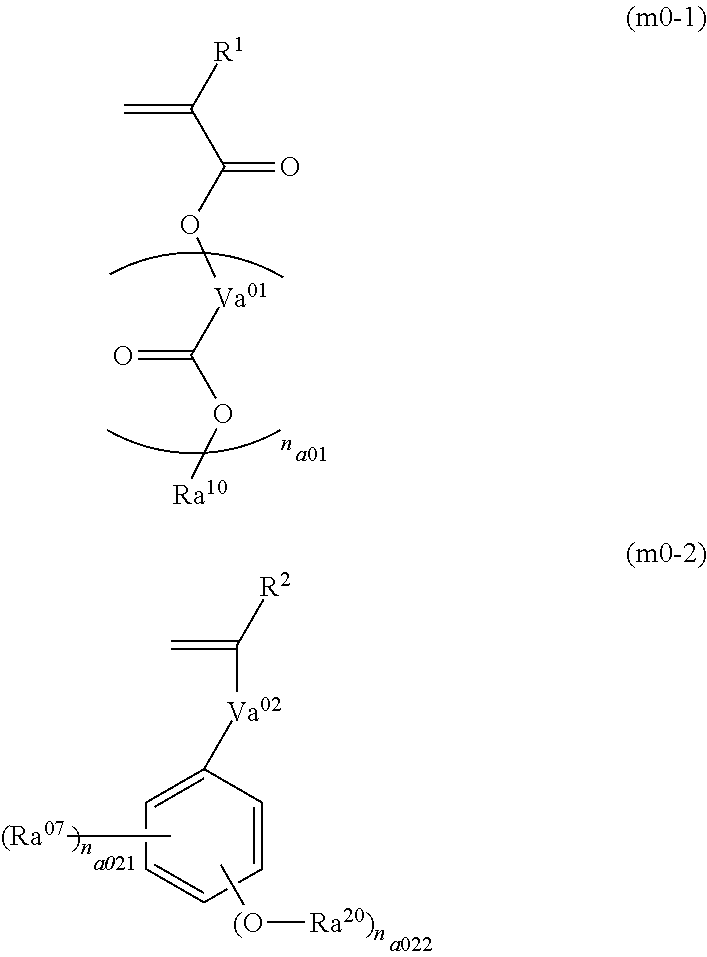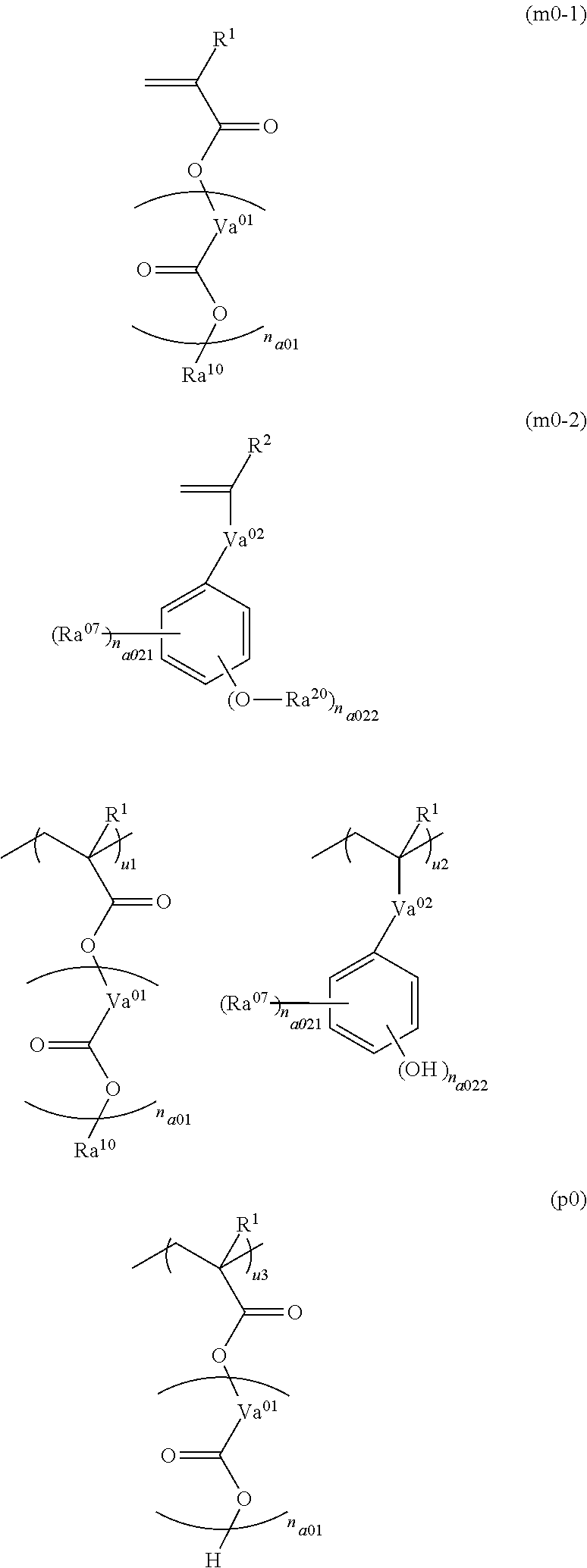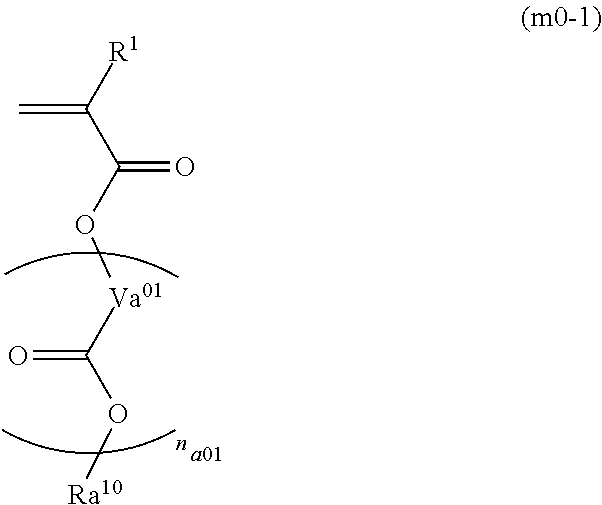Method of preparing polymer compound
a polymer compound and compound technology, applied in the field of preparing a polymer compound, can solve the problems of difficult to satisfy any of the properties, less likely to obtain the desired resist pattern shape,
- Summary
- Abstract
- Description
- Claims
- Application Information
AI Technical Summary
Benefits of technology
Problems solved by technology
Method used
Image
Examples
example 1
Preparation of Polymer Compound (A1)-1
[0650]10.5 g of monomer (a011), 20.0 g of p-ethoxyethoxystyrene (EESt), 1.1 g of 2,2′-azobis (2-methyl propionic acid) dimethyl (V-601) as a polymerization initiator, 62 g of methyl ethyl ketone as a solvent were added into a 300 mL flask, and polymerization reaction was performed at 85° C. for five hours. The copolymer in the polymerization solution obtained by the above polymerization reaction had a mass average molecular weight (Mw) of 8,800 and a molecular weight dispersivity (Mw / Mn) of 1.69.
[0651]Subsequently, 18.6 g of acetic acid and 265 g of methanol were added to the obtained polymerization solution, and the reaction (deprotection reaction) was performed at 30° C. for eight hours. After completion of the reaction, 380 g of heptane was added to the obtained reaction solution, the mixture was stirred and allowed to stand, and then an upper layer (a heptane layer) was removed. Concentrated was performed to provide 100 g of a lower polymer ...
example 2
Preparation of Polymer Compound (A1)-2
[0654]18.7 g of monomer (a012), 35.0 g of p-ethoxyethoxystyrene (EESt), 5.4 g of 2,2′-azobis (2-methyl propionic acid) dimethyl (V-601) as a polymerization initiator, 109 g of methyl ethyl ketone as a solvent were added into a 300 mL flask, and polymerization reaction was performed at 65° C. for seven hours. The copolymer in the polymerization solution obtained by the above polymerization reaction had a mass average molecular weight (Mw) of 8, 800 and a molecular weight dispersivity (Mw / Mn) of 1.69.
[0655]Subsequently, 32.7 g of acetic acid and 470 g of methanol were added to the obtained polymerization solution, and the reaction (deprotection reaction) was performed at 30° C. for eight hours. After completion of the reaction, 600 g of ethyl acetate and 1,200 g of water were added to the obtained reaction solution, and the mixture was stirred and allowed to stand, and then a lower layer (an aqueous layer) was removed. An upper polymer layer was c...
example 3
Preparation of Polymer Compound (A1)-3
[0659]11.3 g of monomer (a013), 20.0 g of p-ethoxyethoxystyrene (EESt), 0.9 g of 2,2′-azobis (2-methyl propionic acid) dimethyl (V-601) as a polymerization initiator, 64 g of methyl ethyl ketone as a solvent were added into a 300 mL flask, and polymerization reaction was performed at 85° C. for five hours. The copolymer in the polymerization solution obtained by the above polymerization reaction had a mass average molecular weight (Mw) of 8, 900 and a molecular weight dispersivity (Mw / Mn) of 1.71.
[0660]Subsequently, 18.4 g of acetic acid and 262 g of methanol were added to the obtained polymerization solution, and the reaction (deprotection reaction) was performed at 30° C. for eight hours. After completion of the reaction, 375 g of heptane was added to the obtained reaction solution, the mixture was stirred and allowed to stand, and then an upper layer (a heptane layer) was removed. Concentration was performed to provide 100 g of a lower polyme...
PUM
| Property | Measurement | Unit |
|---|---|---|
| pKa | aaaaa | aaaaa |
| temperature | aaaaa | aaaaa |
| temperature | aaaaa | aaaaa |
Abstract
Description
Claims
Application Information
 Login to View More
Login to View More - R&D
- Intellectual Property
- Life Sciences
- Materials
- Tech Scout
- Unparalleled Data Quality
- Higher Quality Content
- 60% Fewer Hallucinations
Browse by: Latest US Patents, China's latest patents, Technical Efficacy Thesaurus, Application Domain, Technology Topic, Popular Technical Reports.
© 2025 PatSnap. All rights reserved.Legal|Privacy policy|Modern Slavery Act Transparency Statement|Sitemap|About US| Contact US: help@patsnap.com



